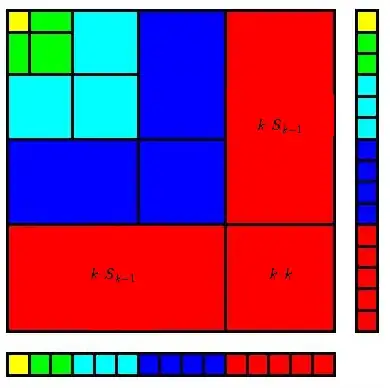Here's a simple bijective proof of a different sort:
Consider a staircase with $n$ steps, built out of $\sum_{k=1}^n k$ blocks. In other words, take the set $\{(i,j) \in \mathbb{Z}\times\mathbb{Z}: i + j \leq n, i > 0, j > 0\}$.
Then $\left(\sum_{k=1}^n k\right)^2$ is the number of ordered pairs $(B_1,B_2)$ of blocks.
And $\sum_{k=1}^n k^3$ is the number of ordered $4$-tuples $(k,b_1,b_2,b_3)$, where $k \in \{1,\ldots,n\}$, and $b_1$ is along the $k$-th diagonal $b_1 \in \{(k+1-j,j): j \in \{1,\ldots,k\}\}$, and $b_2$ is along the bottom $b_2 \in \{(j,1): j \in \{1,\ldots, k\}\}$ and $b_3$ is along the left side $b_3 \in \{(1,j): j \in \{1, \ldots, k\}\}$.
The bijection:
Given an ordered tuple $(k,b_1,b_2,b_3)$, let $A_1 = b_1$ and let $A_2$ given by $b_2$ and $b_3$ as its $x$ and $y$ coordinates, so if $b_2 = (i,1)$ and $b_3 = (1,j)$ then $A_2 = (i,j)$.
Case 1: $A_2$ is on or below the $k$-th diagonal. Then let $(B_1, B_2) = (A_1, A_2)$.
Case 2: $A_2$ is above the $k$-the diagonal. Then let $A_2'$ be the reflection across the $k$-th diagonal of $A_2$. That is, if $A_2 = (i,j)$ then $A_2' = (k+1-j,k+1-i)$. Then let $(B_1, B_2) = (A_2', A_1)$.
The inverse:
To get the inverse, take whichever of $B_1$ and $B_2$ is on a higher diagonal (i.e. has greater sum of its coordinates), taking $B_1$ in case of ties, and let that be $b_1$ and let $k$ be the sum of the coordinates of $b_1$.
Case 1: If $B_1$ is used: Take $B_2$ and let $b_2$ and $b_3$ be given by points with the same the $x$- and $y$-coordinates, respectively, as $B_2$.
Case 2: If $B_2$ is used: Take $B_1'$ (i.e. the reflection across the $k$-th diagonal, as above) and let $b_2$ and $b_3$ be given by points with the same the $x$- and $y$-coordinates, respectively, as $B_1'$.
















